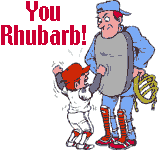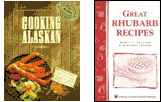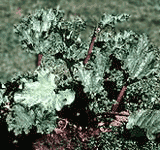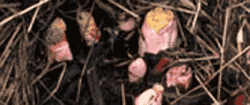
Rhubarb.
Learn about the world's favorite pie plant that people love to hate (Hate to love?)
By Marion Owen, Fearless Weeder
for PlanTea, Inc. and
Co-author of Chicken Soup for the Gardener's Soul
FEATURE ARTICLE:

Tom Hanks' "Power of Four" solution
More good stuff:
Who is Marion Owen?
FAQs about PlanTea
Search Marion's articles, tips and recipes
Why grow organic?
News and press releases
Read love letters
How to link to this site
Need a speaker?
How to contact Marion
Visiting Alaska?
Come to Kodiak Island!
Go to home page

Marion's UpBeet Gardener
Newsletter has been
replaced by Marion's blog
which you can find at:
www.marionowen.wordpress.com
 Rhubarb.
Rhubarb.
My neighbor loves it and my brother hates it. People who move to Florida cry because they can't grow it, while gardeners in Washington can't give enough of it away.
Rhubarb.
Eeee-ow, you pucker up just thinking about it.
Yet its pucker-power is exactly what makes rhubarb the world's favorite pie plant. Ah, but did you know that rhubarb sauce is great served with seafood? Or that it has ties to baseball and it can save the ozone layer? For an entertaining look into the world of rhubarb, plus a 'barb of unique recipes, read on--you're in for a sweet and sour treat.
Fruit or vegetable?
Rhubarb might be a favorite pie plant, but it suffers from an identity crisis. Sunset's "New Western Garden Book" describes rhubarb as an "uncommon vegetable" that's used as a fruit in sauces and pies. Joy of Cooking is even less polite, saying "Only by the wildest stretch of the imagination can rhubarb be included in this [fruit] chapter, but its tart flavor and its customary uses make it a reasonable facsimile, when cooked, of fruit."

I adore rhubarb, so while experts haggle over how to categorize it, I'm
perfectly happy to grow it, cook it, make rhubarb wine, and feed it lots
of compost. In my garden, rhubarb gets front
row status.
How rhubarb is linked to baseball
Thanks to the Romans, the word "rhubarb" takes its name from the Latin rha barbarum. Rhubarb grew along the banks of the river Rha, the ancient name of the Volga. Back then, the region was considered foreign, or barbarian territory. Thus, rhubarb literally means "from the barbarian, Rha."
The use of the word "rhubarb" dates back to the early days of Shakespearean theater, a use that carried forward to present day. Dictionaries first define rhubarb as the lovable, edible plant that it is. Then the slang definition follows. To prepare you, let's get the feeling behind it. Say RHU-barb with attitude. Now you can see how the word became synonymous with a heated argument or squabble. One dictionary even went so far as to link rhubarb to baseball, where a rhubarb meant sparks were flying between the umpire and the pitcher.

Rhubarb loves being cool
Rhubarb loves cool places, even Siberia and Alaska! To winter-weary gardeners, rhubarb is especially appreciated because it's one of the first edibles to appear in the spring garden.
In the kitchen, rhubarb adds a zippy signature to pies and tarts that only rhubarb can do. When combined with strawberries, raspberries, apples, and other fruits, the flavor only gets better. Rhubarb also makes a terrific sauce for chicken, venison, halibut and salmon. Adding diced rhubarb to muffins and biscuit recipes makes them sing with flavor without making the batter runny. Rhubarb, like apples, hold moisture well in recipes. In a little bit, I'll share some rhubarb cake recipes, rhubarb jam recipes, rhubarb muffin recipes--heck, you get the idea.

For
a sampler, here's a quick and easy rhubarb pudding cake recipe that even
rhubarb skeptics will love: Arrange 3 to 4 cups of diced rhubarb on the
bottom of a lightly greased 9x13-inch pan. Sprinkle with 1/2 to 3/4 cup
sugar. Prepare a batter from a boxed white, yellow, lemon, or spice cake
mix, using one less egg than the  recipe calls for. Fold in poppy seeds,
raisins or sliced almonds. Pour the batter over the rhubarb. Bake according
to the instructions on the box. Let it cool slightly before cutting. (You
can also jump ahead to the recipes).
recipe calls for. Fold in poppy seeds,
raisins or sliced almonds. Pour the batter over the rhubarb. Bake according
to the instructions on the box. Let it cool slightly before cutting. (You
can also jump ahead to the recipes).
Not many cookbooks are devoted to rhubarb. Most are scarce or out of print. This is hope, though. "Cooking Alaskan" (ISBN 0-88240-237-4), features unique rhubarb recipes like Strawberry Rhubarb Bars, Rhubarb Fruit Leather and Raw Rhubarb and Berry Relish. One of my favorite cookbooks, Cooking Alaskan, is interesting to read. The seafood recipes alone make it worth it. Then there's "Great Rhubarb Recipes" (Bulletin A-123) by Nancy C. Ralston. Both books are available through Amazon.com.

|
- - -
- - - - - - - - - - - - - - - - - |
How to grow rhubarb
I think the rhubarb plant (Rheum rhabarbarum) is truly beautiful. A member of the buckwheat family, rhubarb has big, heart-shaped, crinkled leaves and red-tinted stalks. Rhubarb is showy enough to qualify for a top spot in a display garden and it's often listed in catalogs as a must-have landscape plant. For the gardener looking for an easy-to-grow food plant, rhubarb tops the list.

Victoria rhubarb from Raintree Nursery produces 3-inch diameter stalks.
(See why I think rhubarb is beautiful?!)
Classified as a Zone 2-9 plant, rhubarb prefers a cool, damp climate, and it struggles in a dry or hot one. This explains why Texas gardeners tell me it's next to impossible. Indeed, rhubarb needs at least two months of cold--not just cool--weather. So if you live in warmer regions, you might have to settle for buying rhubarb in the store or visiting friends and relatives that grow it. All in all, rhubarb is a very forgiving plant. All it asks for is organic, well-drained soil. Rhubarb and organic gardening go together like horse and buggy.
Transplanting rhubarb and other growing tips
To grow rhubarb, the first thing to be aware of is that rhubarb doesn't "breed true" from seed. That means you're better off growing it from root divisions taken from the crown, or base of the plant. Choose a plant with the color of stalk that appeals to you. Red and green stalks don't taste much different, but some claim red stalks taste more like rhubarb than green ones. It might just be a mental thing. Most people prefer red stalks for the color they add to recipes. Tip: 3 to 6 plants are plenty for a family of four (with leftovers for the neighbors in Texas).

Rhubarb plant root showing single shoot
(Encased in mud!)
Common varieties of rhubarb plants include Canada Red, MacDonald, Cherry Red (red stalks), and Victoria (green stalks). (See the resources list below). To plant crowns, set them at least 4 inches deep and 3 to 4 feet apart in holes filled with generous amounts of well-aged manure or compost. Water thoroughly to prevent transplant shock. The leaves may wilt at first, but they will recover. Just be sure to keep them good and moist.
Resources:
where to buy rhubarb plants online and by mail
- Hartmann's Plant Company, Lacota, MI. Phone: 616-253-4281
- V. Kraus Nurseries, Ltd., Carlisle, ON, Canada. Phone: 416-689-4022
- Raintree Nursery, Morton, Washington (360-496-6400) Printed catalog.
- Park Seed Phone: 1-800-845-3369
- Indiana Berry & Plant Co., Huntingburg, IN. Phone: 812-683-3055
- Rider Nurseries, Farmington, IA. Phone: 319-878-3313
(Please email me if these links and phone numbers don't work. Thanks).
As soon as the new rhubarb plants sprout leaves, apply a layer of organic mulch. Side-dress with compost or well-aged manure in midsummer and again in the fall. The more, the merrier. Keep plants moist, don't let them dry out. Rhubarb, like celery, needs lots of water. Otherwise, the stalks become stringy and tough. If you live in a dry climate or rain shadow, or if your rhubarb is located under a tree canopy, consider digging a moat-like depression around the plant. Once filled with water, the moisture can seep in around the plant.
Winter survival tips for rhubarb
A rhubarb plant can withstand a lot of neglect, but it will do sooooo much better if you help it through the winter. After the leaves die down in the fall, bury the crowns with manure, leaf-mold, straw, compost or other organic material. In the spring, pull the mulch away from around the plants to let the sun warm the soil. To protect plants during extreme cold snaps, cover your rhubarb with evergreen boughs. The greens allow moisture to circulate in and out, yet they prevent the wind and cold from drying out the crowns.

Rhubarb "knuckles" poke through
protective straw mulch, a sure sign of spring.
Rhubarb is usually pest-free, but it can be troubled by cabbage worms or a beetle called the rhubarb curculio. A rust-colored culprit, the beetle bores into every part of the plant. Fortunately, they're easily removed by handpicking. Tip: The beetle lives in sourdock plants, so don't grow rhubarb near dock.
How to divide rhubarb plants
Over time, rhubarb crowns become crowded, resulting in small, tough (and somewhat inedible) stalks. That's why it's important to divide your plants every 4 years or so. "My rhubarb plant doesn't produce big leaves anymore," is a common complaint. Divide plants in early spring before leaves get much taller than 6 to 10 inches. Use a shovel to slice down through the crown. Wear heavy boots when you do this! Re-plant crown sections and keep them moist and mulched.
Harvesting rhubarb: it's all in the wrist
When harvesting rhubarb, wait until the leaves are fully developed or nearly so. Pull the stalks away from the base of the crown (like pulling a stalk of celery off the bunch), and then snap it off at the bottom. Avoid cutting stems with a knife, as rot can set in. Also, if this is the plant's first season, harvest only the big stalks, leaving the thinner ones to continue growing and nourish the plant. Never take more than half the stems in one year and stop harvesting altogether by mid-summer. Remember: don't eat the leaves. They're poisonous.
What to do when rhubarb plants send up flower stalks? The jury is still out on this. Some gardeners find the tall, Q-Tip style stalks unslightly and claim the flowers weaken the plant. So they break them off as they develop. Other gardeners enjoy the compact flowers and consider them a wonderful addition to their landscape. Now here's a twist: According to "A Modern Herbal," by Mrs. M. Grieve, some gardeners have discovered that the flowers, when still in bud form, are a pleasant substitute for broccoli.

If you're looking for something rhubarbly different, you're in for a pleasant surprise with sugar free rhubarb recipes, jams, and even a frozen rhubarb daiquiri...
Rhubarb Spice Pancakes
Colorful and tasty, these pancakes are like rhubarb cake, only less sweet. Try them for breakfast or dinner. To two cups of your favorite pancake batter, fold in the following ingredients:3/4 cup finely diced rhubarb
1/2 cup applesauce
1 tsp. ground cinnamon
1/2 tsp. ground ginger
Cook batter on a hot skillet and serve with yogurt, maple syrup or your favorite fresh fruit, jam or jelly.
Sugar Free Rhubarb Pie
The thought of sugar free rhubarb recipes makes your lips pucker. But, sugar free recipes that use rhubarb are easier than you think. For example, take rhubarb cake recipes or rhubarb muffin recipes. When directions call for sugar, replace it with fruit juice concentrates or mild tasting fruit, such as pears or Delicious apples. Here's a sugar free rhubarb pie recipe that will make you a believer.4 cups diced, raw rhubarb
2 cups diced peeled sweet apples, such as golden delicious
1/3 cup apple juice concentrate
1/4 cup unbleached flour
1 tsp. ground cinnamon 1 tablespoon grated orange rind
Line a pie pan with pie dough. Stir the rhubarb and diced apples together and arrange them on top of the pie shell. Combine the remaining ingredients and sprinkle them over the fruit. Dot with 2 tablespoons butter (optional). Cover the pie with well-pricked pie dough or with a lattice. Bake the pie in a 450-degree oven for 10 minutes. Reduce the heat to 350 degrees and bake for 35 minutes or until golden brown. Enjoy!
Rhubarb Jam Recipes
Rhubarb lends itself so well to jam and jelly recipes you wonder why they're not sold in supermarkets. Here are two rhubarb jam recipes that are extra easy--no thermometer, no pectin, just stir!2 pounds chopped, raw rhubarb
8 3-inch strips lemon peel, about 1/4-inch wide (no white pulp, just yellow peel)
1/2 cup water
2-1/2 cups sugar
Combine rhubarb, lemon peel and water in a heavy, non-aluminum 4-quart saucepan. Bring to a boil, reduce heat to a simmer, cover and cook gently for 30 minutes. Stir often. Turn up the heat and begin adding sugar 1/2 cup at a time, waiting for the liquid to return to the boil before adding more. continue cooking over a high heat, stirring constantly. If the jam begins to splatter, turn the heat down slightly. Cook and stir until the jam thickens and reduces to about 3 cups (about 20 minutes).
Remove from heat and fill hot, sterilized 1/2-pint jars to within 1/8-inch of the top. Wipe rims clean, attach new lids and screw caps on tightly. Invert jars to the count of "5" or process in a boiling water bath for 10 minutes. Makes 3 cups. (Note: Make only single batches. Don't try to double or triple the amount).
Rhubarb Ginger Jam: Before cooking rhubarb, add 2 slices fresh ginger root (the size of a quarter). Begin cooking. Remove ginger root slices before adding sugar. At the end of the cooking period (when it's getting good and thick) add 1/3 cup thinly sliced crystallized (candied) ginger.
Frozen Rhubarb Daiquiris
Refreshing, and definitely rhubarb!6 cups chopped raw or frozen rhubarb
1/2 cup water 1-1/2 cups sugar
1 2-liter bottle lemon-lime soda
1 12-oz. can limeaid or lemonade concentrate
1 to 1-1/2 cups white rum
Combine rhubarb and water and bring to a boil over medium heat. Stir in sugar and heat until sugar is dissolved and rhubarb is soft. Remove from heat and strain. Let the liquid come to room temperature. Combine remaining ingredients, add rhubarb juice, and freeze. Stir occasionally while mixture freezes. To serve, simple spoon frozen daiquiris into glasses and top with a sprig of mint.
Rhubarb
to the rescue: aphid spray
and saving the ozone layer
Rhubarb's talents extend beyond pies and cakes. In fact, scientists have discovered that the oxalic acid in rhubarb stems (the same stuff that makes your lips pucker) can be used to scour cooking pots.
If aphids are pest in your garden, rhubarb can help. In her book, "Slug
Bread & Beheaded Thistles," author Ellen Sandbeck describes a unique use
for rhubarb leaves--as an aphid spray. Here's the recipe:
1) Chop 3 to 5 rhubarb leaves and add to a quart of water. 2) Boil for
30 minutes.
3) Strain and add a dash of liquid, non-detergent, soap.
4) Fill spray bottle with liquid and use it on aphids.
Note: Because rhubarb leaves are poisonous, don't use this spray
on edible plants

Rhubarb not only saves our plants from aphids, it may also save the planet. In the mid-1980's, when a hole was discovered in the ozone layer, researchers found that CFC's were one of the primary reasons for the ozone's decline. One of the most common forms of CFC's is freon, which is used as a refrigerator coolant. Conventional methods for breaking down CFC's were costly and dangerous. But in 1995, two Yale scientists discovered that oxalic acid, found in rhubarb, helped neutralize CFC's. Rhubarb to the rescue!
The moral of the story: Even though the pie plant's flavor might be "barbarum" to some, never underestimate rhubarb!
Thanks for visiting and please stop by again. I'll put the coffee on!
Meet Marion Owen /// Learn about PlanTea /// Online Catalog /// Articles, Tips, Recipes /// Get free UpBeet Gardener newsletter /// Read current issue /// Listen to radio show /// Read news and press releases /// More resources and links /// Learn why 'grow organic?' /// View guidelines for retailers /// Read love letters /// Book Marion as a speaker /// Site map /// How to link to us /// Contact us /// Go to home page
PlanTea: The organic plant food in tea bags. http://www.plantea.com
Copyright ©1996 to present: PlanTea, Inc. All Rights Reserved. PO Box 1980, Kodiak, AK 99615-1980 USA
Questions or comments? marion@plantea.com Phone: Toll Free: 1-800-253-6331 (US and Canada); 907-486-2500